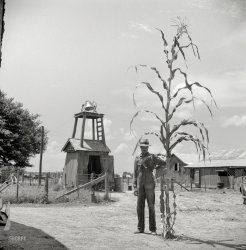
MAY CONTAIN NUTS

Search Shorpy
SHORPY ART

Framed or unframed, desk size to sofa size, printed by us in Arizona and Alabama since 2007. Explore now.
Join and Share
Ad-Free Shorpy
Shorpy is funded by you. Patreon contributors get an ad-free experience.
Learn more.

Recent comments
- Tough Guys
- Lost in Toyland
- And without gloves
- If I were a blindfolded time traveler
- Smoke Consumer Also Cooks
- Oh that stove!
- Possibly still there?
- What?!?
- $100 Reward
- Freeze Frame
- Texas Flyer wanted
- Just a Year Too Soon
- WWII -- Replacing men with women at the railroad crossing.
- Yes, Icing
- You kids drive me nuts!
- NOT An Easy Job
- I wonder
- Just add window boxes
- Icing Platform?
- Indiana Harbor Belt abides
- Freezing haze
- Corrections (for those who care)
- C&NW at Nelson
- Fallen Flags
- A dangerous job made worse
- Water Stop
- Passenger trains have right of way over freights?
- Coal
- Never ceases to amaze me.
- Still chuggin' (in model form)
Member Photos
The Shorpy
Print Emporium
Print Emporium
Search Shorpy
Search results -- 30 results per page
- Bike Chained: 1920
- ... April 24 and are not to be opened until his return to that city. Pizzo made a California to New York trip in like manner in 1919." View ... I guess things could get pretty dicey out in the wilds of Kansas or wherever. Though, as a kid I got chased by a lot of mean dogs while ... Posted by Dave - 06/09/2015 - 12:07am -
![Bike Chained: 1920 May 1920. "Sailor Tony Pizzo passing through Washington on a Coast to Coast bicycle run handcuffed to his machine. The handcuffs were sealed by Mayor Hylan in New York April 24 and are not to be opened until his return to that city. Pizzo made a California to New York trip in like manner in 1919." View full size.
Buttons on his jumperBack during the Vietnam War ,when I was in the Navy, sailors modified their jumpers to make a better, and tighter, fit. These uniforms were called "tailor mades" Modern versions have a zipper. I suppose that they still do today.
The morning regularI am less impressed by the physical feat of crossing the country handcuffed to a bike than I am with the thought of simply taking care of, shall we say, the less pleasant daily chores of life, and finding places (and people willing to help him) to do so. I choose to believe that he was allowed his own key to the handcuffs to facilitate his “private time”.
Bathroom BreakI will be the first to ask since I know that almost every Shorpyite wants to know.
How did he go to the bathroom chained to a bike?
Also, did he sleep on top of the bike or underneath?
Just asking?
According to the story I found, he was not allowed to unchain himself and had done the necessary whilst still chained to the bike. It was, however, specially designed for him to be able to do that.
More About TonyTony suffered from tuberculosis and was about to be discharged from the Navy when he undertook the trip from CA to NY.
More about that here.
He had a pal who got hit by a car on the first trip and had to go it alone the first time.
His friend was his manager the on the trip viewed here.
When they tested him in 1920 he was clear of Tuberculosis and was able to stay in the Navy.
Where did he ride?It looks like he might have started out in Central Park, because he has a pistol hanging under his seat.
What! No Chain Guard?As a kid I would roll up my pants leg to keep my threads from becoming ensnared while pedaling merrily down the street.....wonder if Tony did the same.
A Gun!?!, etcI guess things could get pretty dicey out in the wilds of Kansas or wherever. Though, as a kid I got chased by a lot of mean dogs while on a bike that could probably go faster than the one he's on. The ability to have a ranged weapon rather than relying on a PF Flyer to the snout could have been handy.
Speaking of bikes it seems that coaster brake technology had been developed by 1920 since it doesn't appear that there are any brake levers on the handle bars.
A Pair of IversThe bicycle is an Iver Johnson. Not sure of the year, but likely mid teens.
The grips on the revolver also look Iver Johnson-ish too.
Fall of 1920The overcoats are a clue but the Motion Picture magazine in the woman's arm is from November, 1920.
ImpressedI can't even imagine riding that bike even 10 miles, let alone across the country. Twice!
I recently did a 210 mile bike ride over two days.
I rode a bike with 27 gears that I'm sure weighs half of what this bike weighed. I was able to wear modern technical clothing. I wasn't chained to the bike. I had mechanical support along the route, several rest stops fully stocked with snacks. And there was a truck to carry my tent and sleeping bag to my overnight location.
Compared to this guy, I'm a softie. Maybe next year I'll try it his way.
Holster legend?Does it say "Dogs Only" on his holster?
So, aside from the other private matters, he could not change his shirt, with both hands chained. Hmmm.
[Notice how long the chains are and the buttons up the entire length of the sleeve. -tterrace]
What about tire changes?It seems like an unnecessary measure to have those chains on. What's he going to do, conspire to defraud the public trust?
[It's a stunt. -tterrace]
Ready for anythingJunkyard bike: check.
Semi-flat front tire: check.
Handcuffs: check and double check.
"Repel boarders" equipment: check.
Helmet: er..... check.
Odd looking pedal resistant shoes: check.
I am familiar with 13-button trousers, but the button-down-the-sides-and-down-the-sleeves dress blue jumper is new to me. It may have been standard in 1920, but I suspect that it is an accommodation to Seaman Pizzo's particular situation. I'm sure that the trip through Needles in dark blue wool clothing would have been less than pleasant. Maybe he had tropical whites in the trunk.
Bike equipmentOr more importantly the lack of it. I used to put in about a thousand miles a year back in the day and I gotta say those shoes must have been painful. And the pedals don't have even the most basic toe clips to give some pedal lifting during the power cycle.
It looks like the pistol might rub against his leg and one wonders what he's planning offing. But I vividly remember cycling into Yellowstone Park and noticing a sign that said, "Keep Windows up"
Counting the milesI was immediately drawn to the odd-looking nut near the front axle, and recognized the mileage counter located there. The counter on my old Carlton was the same compact style.
My mileage counter ... was manufactured by Lucas and purchased in the '50s. It is possibly an updated design since the mount looks the same.
You can see the actuating pin mounted on one of the spokes - it moves the "Cyclometer" 1/5th of a turn for each revolution of the bicycle wheel.
For you bicycle enthusiasts this was (and still is) mounted on a one-owner 1948 Hex-Tube Monark Silver King.
ButtonsI served over 20 years in the US Navy. From 1983 to 2006 and the men's Service Dress Blue jumper never had zippers. The trousers had buttons and the jumper was "tailored" for a fitted appearance but had no zipper or buttons other than those at the cuffs. Sailors would take their jumpers to a tailor shop and have a zipper put into the side seam to make it easier to put on/take off, especially as we put a few pounds on as the jumper was fitted during boot camp.
Needles isn't always so hotThere was a remark on here about the bicyclist being overdressed for Needles. I live in Needles and it does get hot here in the summer. It is a four season location, although the winters aren't nearly as severe as the summers. One comment was made about the magazine in the woman's arm being dated November 1920. If that's the case and the magazine is new, he was dressed fine for Needles, except he might even need a pea coat. It's cold between November and March.
(The Gallery, Bicycles, D.C., Harris + Ewing)](https://www.shorpy.com/files/images/SHORPY-30431a.thumbnail.jpg)
- Superior Street: 1909
- ... Oregon, Idaho, Montana, Arizona, New Mexico, Texas, Kansas, Louisiana, Missouri, and Minnesota.
1915
The Hearst newspapers, ...
Let's not forget The best 5 cent lunch in the city. Was it the Hot Beef Tea that they were advertising?
Hot Beef Tea ... Posted by Dave - 08/13/2012 - 6:42pm -
![Superior Street: 1909 Duluth, Minnesota, circa 1909. "Superior Street." The newsboy's headline: JAP RIOT CRISIS. 8x10 inch glass negative, Detroit Publishing Co. View full size.
Maybe he stepped on a hatTwo things on the right immediately caught my attention:
1. There is a bald man walking down the street; he appears to be the only man in downtown Duluth not wearing a hat. He must have met with some devastating hat disaster. That shiny pate REALLY sticks out!
2. The man in front of Fitger's Beer who is looking down at his feet or something on the ground. I'm pretty sure he was saying or thinking: "Aw man, what did I just step in?"
Coming or going?This guy doesn't appear to be a window washer!
The Lyceum TheatreSaid to be Duluth’s first “fire-proof” theatre. It was built for live theatre in 1892, but in 1921 it was converted to showing movies. Demolished in 1963.
What did the Japanese do?To get that headline.
Fitger's beerhttp://www.fitgers.com/subpage.php?page=History
Hawaii RiotsThe newsboy's headline concerns an incident during a labor strike by 10,000 Japanese sugar plantation workers on the island of Oahu in Hawaii. The wire service "riot" story was datelined "Honolulu - June 9" and ran in the New York Times on June 10, 1909. The wider story about this strike and its developments ran in many mainland newspapers throughout June and July, and concerned the efforts of Japanese sugar workers in Hawaii to achieve a wage increase from $18 per month to $22 per month. Much of the press coverage seems to have focused on "yellow peril" conspiracy fears, but a more nuanced report, "Who Will Develop the Wealth of Hawaii?" ran in the Times on June 27, detailing new efforts by white plantation owners to attract Filipino, Portuguese and Puerto Rican immigrants to replace the "restless and ambitious" Japanese.
News of the day?Can we get a close-up of the newsie to read his tantalizing two-word headline? Any guesses?
[Anyone read the caption under the photo? - Dave]
Spot the signIt looks hot and dusty -- perfect venue for a Coca-Cola advertisement!
Jap RiotThe headlines referred to riots in California due to a spate of new laws affecting the Japanese population. Below is an outline of the years before and after the riot. It clearly paints a picture for what happened during WWII.
1906
San Francisco School Board orders segregation of 93 Japanese American students.
1907
On orders from President Theodore Roosevelt, S.F. School Board rescinds segregation order, but strong feelings against Japanese persist. Anti-Japanese riots break out in San Francisco in May, again in October, much to the embarrassment of U.S. government.
Congress passes immigration bill forbidding Japanese laborers from entering the U.S. via Hawaii, Mexico, or Canada.
1908
The Asiatic Exclusion League reports 231 organizations affiliated now, 195 of them labor unions. U.S. Secretary of State Elihu Root and Foreign Minister Hayashi of Japan formalize the Gentlemen's Agreement whereby Japan agrees not to issue visas to laborers wanting to emigrate to the U.S.
1909
Anti-Japanese riots in Berkeley. U.S. leaders alarmed at tone and intensity of anti-Japanese legislation introduced in California legislature.
1910
Twenty-seven anti-Japanese proposals intro-duced in the California legislature. White House urges Governor Hiram Johnson to seek moderation.
1913
Alien Land Law (Webb-Haney Act) passed, denying "all aliens ineligible for citizen-ship" (which includes all Asians except Filipinos, who are "subjects" of U.S.) the right to own land in California. Leasing land Iimited to 3 years. Similar laws eventually adopted in Washington, Oregon, Idaho, Montana, Arizona, New Mexico, Texas, Kansas, Louisiana, Missouri, and Minnesota.
1915
The Hearst newspapers, historically hostile to Japanese, intensifies its "Yellow Peril" campaign with sensational headlines and editorials, fueling anti-Japanese feelings.
Something's missingCan't find the United Cigar Store!
Another Japanese connectionIn addition to the "JAP RIOTS" headline, a sign on the Great Northern Railway office announces steamship sailings from Seattle to Yokohoma and Kobe.
On a completely separate note, while street crowds in most vintage cityscapes tend to be predominately male, this one is the most extreme, with almost no women visible. It looks almost like a modern street scene in the Middle East.
I'll passon the Hot Beef Tea! Although 5 cents is a good price for lunch.
Count 'emThere are THREE trolleys running up this street. If I missed one, no problem! I could just wait a minute and hop on the next one!
Let's not forgetThe best 5 cent lunch in the city. Was it the Hot Beef Tea that they were advertising?
Hot Beef TeaThat's what it looks like the sign says. Or maybe it's Hot Beet Tea, which sounds even worse.
How to make it:http://www.thestrugglingcook.com/beef-tea.html
Beef teaBeef tea is nothing more than what we now know as beef broth, beef bouillon, or beef consomme. One of my unfailing go-to beverages when I am feeling puny, or (unfortunately) on a liquid-only diet. Why it was a big deal in 1909 I have no idea. I am more concerned about the dude in the window, whether he is coming or going. My theory is that the husband came home unexpectedly.
(The Gallery, DPC, Duluth, Streetcars)](https://www.shorpy.com/files/images/SHORPY_4a23201a.thumbnail.jpg)
- Angel of History: 1942
- ... B-25 bomber cowl assembly, North American Aviation, Kansas City, Kansas. October 1942. View full size. 4x5 Kodachrome transparency by ... Posted by Dave - 08/03/2012 - 3:37pm -
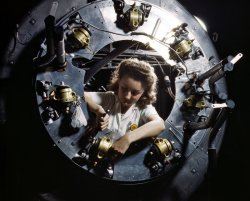
- The Old Paxton Place: 1938
- ... The Oregon Trail wasn't even close. It ran west from Kansas City, crossed the Kansas River at Topeka, and then went northwest into ... Posted by Dave - 08/08/2020 - 6:44pm -
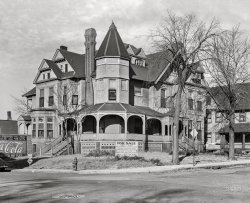
- West of Dodge: 1957
- ... it is. -tterrace]
(yay! - bohneyjames)
Dodge City? My husband loved all things cowboy. But being from Kansas he got a big kick out of all the mountains around Dodge City depicted in ... Posted by Dave - 02/04/2014 - 1:59pm -
![West of Dodge: 1957 July 1957. "Actor James Arness filming on location for the television series Gunsmoke." Photo by Maurice Terrell for the Look magazine article "Jim Arness: Hero of Gunsmoke." View full size.
Veteran Character ActorSimon Oakland, who infamously played gumshoe Vern St. Cloud on The Rockford Files, appears to be reclining on his saddle in the foreground, having just enjoyed a swig from his almost-period canteen. (Could the episode being filmed have been "Overland Express" which aired 31may58?)
[Indeed it is. -tterrace]
(yay! - bohneyjames)
Dodge City?My husband loved all things cowboy. But being from Kansas he got a big kick out of all the mountains around Dodge City depicted in Gunsmoke.
Dodge COELooks like a Dodge COE in the background (the 4 door truck). Judging from the lighting, I'd say they're, what, South East of a Dodge?
Cowboy ClothesI would bet no cowpoke was ever as well dressed as these guys! Check out the rack of costumes on the distant right.
Wildwood ParkThe location depicted here is now in Wildwood Park (or in the abutting housing tract) in Thousand Oaks California. The view is to the Northwest, with Mount Clef Ridge in the background.
(Frontier Life, LOOK, TV)](https://www.shorpy.com/files/images/SHORPY_00995u.thumbnail.jpg)
- Snow Angels: 1922
- ... Time: It's currently a little over 100 degrees here in Kansas City, and that snow looks so cool. If I could go back in time, I'd like to ... Posted by Dave - 08/02/2012 - 5:48pm -
![Snow Angels: 1922 "Blizzard, January 28, 1922." In Washington, D.C., freezing weather is no match for a sunny disposition. National Photo Company glass negative. View full size.
Our eyes met across a crowded centuryI don't know how many men will fall in love with these two today, but I know I'm one of them.
Frozen SunshineSunny dispositions indeed. These lovely ladies make that luxurious blanket of snow look downright warm!
(Thank you, stanton_square, for all of the light you shed on so many of these posts. I don't know how you find the time to do it, but I'm sure glad that you do!)
Simply gorgeousI wish I knew where I stashed Claybuster's time machine. . . I want to beat him to the one on the left!
Shakespeare says So long as men can breathe or eyes can see,
So long lives this, and this gives life to thee.
http://poetry.eserver.org/sonnets/018.html
Snow AngelsWow... beautiful women. I wish there were a time machine.
[Ooh. "Snow Angels." May I steal that as the revised title for this post? Thanks! - Dave]
No two alikeThey are so naturally pretty--even their smiles are real. Beauty seems so plastic (or silicone) today. What a loss.
Sensible ClothesThe blizzard was noted as an occasion when normal dress norms were relaxed, allowing women to don breeches instead of skirts.
Femininity Fares Bravely Forth
In Breeches, Silks and Goloshes
The feminine wayfarers in the storm yesterday held their own in the matter of endurance, and seemed to enjoy the long walks to and from the government departments and the shopping centers. Many of them won masculine approval by the sensible clothes they wore to combat the elements. Sports hats, sensible coats, high shoes, wool stockings and "goloshes" were the favorite footwear.
The fortunate women and girls who owned riding breeches wore them under their long or short coats, making it possible for them to go through the highest drifts without difficulty.
...
Instead of attending the Saturday matinee, beloved of seminary girls, the students of a fashionable girls' school, dressed for a snow fight, built forts and snow men and shoveled snow in the front yard of the school and ended up with a "pitched battle" of snow balls which would put the historic "pillow fights" to shame.
Washington Post, Jan 29, 1922
I'm bewitched!The relaxed cold weather dress code makes these long-legged lasses all the more elegant and attractive. It must have been a treat for the gents and the incorrigible "girl watchers"!
What a pair of dollsLovely girls. Their eyes are similar -- I wonder if they're sisters?
Tragedy awaitsLater that evening this same snowstorm brought down the ceiling of the Knickerbocker Theater.
If I Could Go Back in Time:It's currently a little over 100 degrees here in Kansas City, and that snow looks so cool. If I could go back in time, I'd like to meet the one on the right! They're both very pretty girls.
(The Gallery, D.C., Natl Photo, Pretty Girls)](https://www.shorpy.com/files/images/05679u.thumbnail.jpg)
- First Flight: 1942
- ... Aviation, almost ready for their first test flight. Kansas City, Kansas. October 1942. View full size. 5x4 Kodachrome transparency by ... Posted by Dave - 08/04/2012 - 11:03pm -
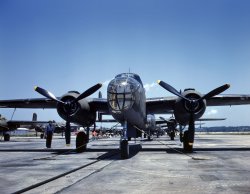
- Kodachrome Karnival: 1979
- ... Minneapolis and the closest two labs were in Chicago and Kansas City. All the labs were licensed by Kodak and had to adhere to a certain ... Posted by tterrace - 01/08/2011 - 3:41am -
![Kodachrome Karnival: 1979 Last week saw the last processing run for Kodachrome film, as noted on Shorpy here. I thought that this one, shot by my friend in 1979, was a good example of what all the hubbub was about. It's at the Sonoma County Fair in Santa Rosa, California. View full size.
Washington Post: Eulogy for KodachromeThere's a great narrative, with an accompanying slide show, in which Washington Post photographer John McDonnell eulogizes Kodachrome, the iconic film produced by Kodak from 1935 to 2009.
You'll have to put up with a short commercial intro, but the narrative and slide show are worth the wait! (Make sure your volume is turned on.)
Kodachrome scanningFirst of all, there's no such thing as a "straight" translation of any kind of photochemical image to another medium, even if it's another photographic emulsion. In that case, there are differences in the pigments and dyes used in the photographic materials. In the case of standard four-color printing, such as for books and magazines, the pigments are entirely different chemically. Furthermore, there's no way to replicate the contrast range of a color slide viewed by transmitted light on a print viewed by reflected light. When we get into digital scanning and display, there are further complications: the scanning light source, the color sensitivity of the image sensors and even the spectral characteristics of the film itself. (This is a particular problem with Kodachrome, which we faced when I was working in our custom color lab; we could achieve reasonable color accuracy in making duplicate slides and prints from Ektachrome, but doing so across the spectrum with Kodachrome originals was often impossible.) With digital, there's the additional complication of the final display, whose colors are produced in a different manner altogether. And again, the contrast range of a projected color slide exceeds that possible with a standard computer display. The best we can achieve is a reasonable simulation of what's on the slide.
Then there's another angle: not all Kodachrome processing was equal. Processing done by Kodak itself was the most consistent, but that from other labs could be all over the map; our own collection of hundreds and hundreds of Kodachrome slides over a span of over three decades provides ample proof of that. We have greenish Kodachromes, magenta-tinged Kodachromes, reddish Kodachromes, bluish Kodachromes, cyanish Kodachromes and others that are off one way in certain colors and another way in others. This particular slide is from a batch processed by some unidentified lab, and they're all consistently reddish/magenta compared to the standard processed-by-Kodak color that I'm thoroughly familiar with. I decided to correct that out to something that looked, to my eyes, more like a Kodak-processed Kodachrome. Below is a version that's close to what the original slide looks like; I can guarantee that the asphalt of the fairgrounds was not red.
Not as red as blueExcepting the sky is brite blue, I see this image as heavy with blue, and not as warm red as Kodachrome normally gave. Perhaps it is the age of the image as well. I did a quick adjustment and increased the color overall except contrast. The result is what I thought Kodachrome normally revealed. Just my opinion though.
[Put on your sunglasses. - Dave]
KodachromeI guess I am spoiled by digital photography.
I think the color in this image is average. Also, is this a straight scan without digital manipulation?
I enjoy this site. Keep up your good work.
Doug Santo
Pasadena, CA
Sounds like a song titleBeautiful colors, too late though. Someone has already taken my Kodachrome away.
I remember fairs like thisThis scene was repeated thousands of times across North America in the mid 70's and early 80's. I could have been one of the three kids standing by the fence. I love the fact that the rides, while brightly painted, aren't cluttered with all sorts of advertising like they seem to be now. I remember riding most of these, the Hurricane, the Yo-Yo and as the sing says, the TipTop.
My favorites were The Scrambler, the Loop-O-Plane and the Tilt-A-Whirl. Wagner Shows, a Western Canadian outfit which served our town, used to feature a fellow who rode the deck of the Tilt-A-Whirl while the ride ran, nimbly stepping between the buckets, giving each an extra spin at just the right moment. He wore a t-shirt that read "Tilt the World with Joe".
Anyhow, I very much like this photograph. It's one of the few shown here new enough to allow one to suppose that at least some of the people in it aren't obviously dead.
Kodachrome realismAll the hubbub (for me, at least) is Kodachrome's ability to make then look and feel like now.
A couple of years ago David posted a Kodachrome of a female factory worker in a WW2 aviation plant (I think) and a young man posted a response saying he was convinced beyond all doubt that the photo was a fake. It just did not seem possible to him that a picture from that long ago could look so vivid and immediate.
I can see why he might think that because Kodachrome could make 60 years ago look like yesterday.
Foy
KodachromeIf that's a 35mm transparency, I wish I had spent more time working with Kodachrome than Ektachrome. Amazing detail, colour and texture. Too bad it required a crystal clear day like this to stop motion.
Awww, c'mon nowNot at all fair to judge the benefits of Kodachrome by today's digital software manipulation. Back then, you got what you got. And, when it came to printing, only Cibachrome could really capture the essence of the Kodachrome transparency. And yes, even then a wee bit of "manipulation" was possible. We shouldn't compare apples to oranges.
Kodachrome vs. DigitalIn 50 years this transparency, barring disaster such as a fire or flood, will look just like this. In 50 years any digital photograph, unless painstakingly re-saved to the latest storage media, will be non-existent. If you print the digital photo to paper with an ink jet printer, it will have long since faded into a mere ghost of its original glory.
Re: Kodachrome vs, Digital>> In 50 years any digital photograph, unless painstakingly re-saved to the latest storage media, will be non-existent.
This is an oft-repeated canard without much basis in fact. Your average flash memory card should be good for many decades of storage. With billions of them currently in use, there'll be a market for card readers for decades to come, even after the various formats become obsolete. The same is true for hard drives and most other mass-storage media. (Or you can just keep your photos online -- my oldest albums have been online for 15 years now.)
For most folks, the storage medium of choice is prints. Inkjet prints made on good paper with dye-based inks have permanence ratings of 100 years or more.
WOWWhat an incredibly interesting and fascinating work of art.
KodachromeColor just oozes.
Re: Kodachrome vs. digitalI used Kodachrome for many happy years, beginning in the ASA 25 years. I was fortunate in living close enough to one of Kodak's own labs, so processing was always consistent.
I don't think K-chrome's prime asset was realism as much as it was beauty. Rich colors - in my experience, more so than digital -- set it apart. Ektachrome was the "bluish" film; Kodachrome brought out the deep warm tones.
Ultimately, I switched to Fuji film because later high-speed versions of K-chrome weren't as satisfying as the ASA 25 variety.
If K-25 was still available, I'd be using it today, and my digital equipment would be gathering dust.
Projection - Yes!Too bad such a wonderful film is gone. Tterrace nails the problem with duplicating, digitizing or printing any transparency right on the head.
The only thing I havn't experienced is the variance from other labs. Here in the midwest the labs were quite spread out. I processed Kodachrome in Minneapolis and the closest two labs were in Chicago and Kansas City. All the labs were licensed by Kodak and had to adhere to a certain quality standard to maintain their license. I remember that the chemical department had analysis equipment that wouldn't be found in any other photo lab and I had to calibrate the cyan and yellow printing lamps before every run.
Just an interesting sidenote, EPA compliance and monitoring was always a problem because the cyan developer had a high level of cyanide that went down the drain from the tank overflow.
What's gone is gone.I make no apologies for the fact that the passing of Kodakchrome 35mm slide film does not bring a tear to my eye or a lump to the throat.
I'm 65 years old and have used my share of slide and print film over the past 40 to 50 years, including Agfa, Fuji and Kodak products. I have boxes of Kodak Carousel containers filled with slides, and smaller plastic boxes as received from the processing labs filled with slides.
Many, many of them show signs of deterioration, no doubt due to careless storage.
I'm what anyone would call a rank amateur, a "snapshot-shooter," and although I still have my Nikons I have not used them since 2001, preferring instead the ease and economy that several digital cameras give me.
No, not for me the crocodile tears as I wave goodbye to Kodachrome. I'll gladly store my photographs on USB memory sticks or DVDs, keeping only the best of a mediocre bunch and only paying for prints of the really special ones.
And I doubt that any other "snapshooter" would feel any different.
We will miss you Gives us the nice bright colors, the greens of summer, makes all the world a summer's day. (Sorry Paul, best I can remember at my age).
(ShorpyBlog, Member Gallery, tterrapix)](https://www.shorpy.com/files/images/KodachromeKarnival1978.thumbnail.jpg)
- And a Little Child: 1939
- ... Globe-Democrat, which would have been the closest "big city" papers. The Post-Dispatch is still around, but the Globe-Democrat ceased ... Fuller department store in St. Louis. Stix expanded to Kansas City and I remember going there with Mom when I was young. It was ... Posted by Dave - 02/02/2018 - 6:11pm -
![And a Little Child: 1939 November 1939. "Former tiff miner, now blind, with son. Washington County, Missouri. Photographs show mining and miners of tiff, form of white lead used in paint. A dangerous occupation because tiff mines are never timbered and all mining is done by hand labor from crude holes in ground usually 10 to 15 feet deep." Photo by Arthur Rothstein, Farm Security Administration. View full size.
Lead Mining in S.E. MissouriLead was a huge industry in S.E. Missouri, producing about 1/3 of the lead mined in the U.S. at any given time. The ore was found in a couple of large areas within about 60 miles south and west of St. Louis. Washington County was in the upper left corner of the "lead belt" region.
There is film of tiff mining by hand in this area, probably from the 1930s and difficult to watch, showing how it was done and also some of social problems that accompanied it: https://www.youtube.com/watch?v=tU7Ovb5NtaI
This video from 1948 is about hard-rock mining in the Missouri lead belt and gives a lot more information about where the ores were found and how the more common types (e.g., galena) were mined and processed: https://www.youtube.com/watch?v=6HhdkkdsvTM
Some are survivors, some have disappearedThere used to be quite a lot of iron, lead, and zinc mines in southern Missouri. Lead is still mined today in Washington County and surrounding counties. The Missouri School of Mines was founded in 1870 in Rolla (about 50 miles west of this photo), to train engineers for the mines. It later became part of the University of Missouri system.
The walls are covered with pages of the St. Louis Post-Dispatch and St. Louis Globe-Democrat, which would have been the closest "big city" papers. The Post-Dispatch is still around, but the Globe-Democrat ceased publishing in 1986.
At the top right of the mirror is an ad for the Stix, Baer, and Fuller department store in St. Louis. Stix expanded to Kansas City and I remember going there with Mom when I was young. It was eventually sold to Dillard's, and then Macy's.
Tiff is also still mined today, but the process is much different than it was in 1939. One large deposit of it is near the Virginia-Maryland border and is owned by the federal government. The feds extract the tiff and supply it to private processors, who must use automated equipment to handle it - no manual processing. This equipment compresses the tiff into a more compact form that is easier to ship and to use for further processing.
4 year old paperThe Ripley's Believe it or Not cartoon that can be seen to the left of the mirror next to the shoes was published in the Aug 29, 1935 edition of the St. Louis Post-Dispatch, making the paper lining the walls over 4 years old. Items it covered included John G. Zook who recopies the items he wrote 50 years ago for the same newspaper, a clothespin used for 62 consecutive years by Mrs. Mary Richmond, the Mormon Nauvoo Temple, and Eddie Cole of Galveston who pitched a perfect game of baseball.
Tiff is Barium Ore, not LeadI wasn't familiar with the term "tiff" until I saw this photo caption, but research indicates it refers to barite or barium sulfate ore. There were a lot of barite deposits in the area - in fact if you look at old topo maps you can see small mines all over the place, some of which are lead, and some barite.
Fortunately barium sulfate is not nearly as toxic as lead ores, so we don't have to feel quite so sorry for the poor lad in the picture. Although he may be lead-poisoned anyway, just from living around the mines and smelters.
[Trachoma, a bacterial infection, was the cause of blindness among Missouri's miners of tiff, a substitute for white lead in paint. - Dave]
(The Gallery, Arthur Rothstein, Kids, Mining)](https://www.shorpy.com/files/images/SHORPY-8b19207a.thumbnail.jpg)
- Knott's Berry Farm: 1964
- ...
Being from Indiana and never any farther West than Kansas City, Kansas, I was always fascinated by the lure of the West Coast.
Still, ... Posted by tterrace - 11/12/2016 - 5:18pm -
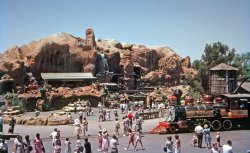
- Dairy Queen: 1942
- ... alive.
[EDIT: It's hard to discern which, but the city might be "N.Plainfield" or "S.Plainfield," both of which sit just adjacent ... camp (as we called it) at Fort Hays State College in Hays, Kansas, in the summers of 1963-65. It had none of the prestige of Interlochen, ... Posted by Dave - 01/27/2013 - 6:51pm -
![Dairy Queen: 1942 August 1942. "Interlochen, Michigan. National music camp where 300 or more young musicians study symphonic music for eight weeks each summer. A student eating an ice cream cone." Photo by Arthur Siegel. View full size.
A Pretty Girl Is Like A MelodyThe fly is smiling, too.
What a cute girl!Got to love that smile, just a little on the dangerous side.
Dully NotedThose were the days before permanent press. Everything had the marks of ironing.
Also black flies.
The pin on her collarThe little violin suggests her choice of instrument. I agree with Zoomer -- a dangerously cute smile.
Summer camp in knickersI went to Interlochen in the mid-'60s. What an enjoyable place. There's nothing quite as nice as being serenaded to sleep at night by strolling musicians.
I Hope That there were not too many broken hearts in the horn section of the Interlochen Camp Orchestra.
IDHer badge indicates that she's Judy Lambert, from Plainfield, NJ. Judging from the photo, she'd have been born in the mid to late 1920s, making her almost 90 if she's still alive.
[EDIT: It's hard to discern which, but the city might be "N.Plainfield" or "S.Plainfield," both of which sit just adjacent to Plainfield, NJ.]
Band campI went to band camp (as we called it) at Fort Hays State College in Hays, Kansas, in the summers of 1963-65. It had none of the prestige of Interlochen, but we had fun, too. This photo is very evocative.
A guy could fall in love . . . .Amazing what a freckled cheek, a saucy haircut, a coy and confident smile, and . . . well, an ice cream cone on a warm summer day, can do to a fellow.
I like this girl.
Re: A guy could fall in love . . . .A guy did (and a Scion of Industry and fellow violinist at that). She married him in 1950 and they had three kids and seven grandchildren. He died last year and she's named as a survivor in the obit, so no names for privacy's sake. But it looks like our girl had a pretty good future waiting.
Classic BeautyI'll bet Ms. Lambert had no idea she would be making men swoon 70 years later. I love this photograph - my wife went to Interlochen for high school, and she had to wear those knickers.
(The Gallery, Arthur Siegel, Music, Pretty Girls)](https://www.shorpy.com/files/images/SHORPY_8d21678u.thumbnail.jpg)
- Oyster Shuckers: 1912
- ... a while. No, I didn't live in "the hills." I lived in Kansas City, Missouri, and was in my early 30s. I have a college education, and know ... Posted by Dave - 02/01/2008 - 8:44pm -
![Oyster Shuckers: 1912 February 1912. Port Royal, South Carolina. "Bertha, one of the six-year old shuckers at Maggioni Canning Company. Began work at 4 a.m." View full size. Photograph (glass negative) and caption by Lewis Wickes Hine.
Wow.This one really got to me. I have such an easy life.
BerthaPeople who go on and on about the "good ol' days" should reflect. So haunting, even more so than the other shucker photos. Six. Years. Old.
So SadAnd the kids today think they have it tough. This photo makes want to cry.
Oyster shuckersI've seen a little of the so-called third world. While the United States has pockets of abject misery, most of those we consider poor here have a standard of living light years ahead of the rest of the world.
"Back in the day" almost everyone worked long hours, with little rest or diversion. It was considered normal. I'm glad most of our children now have the luxury of enjoying life. Some of them, though, could stand the discipline and rigor of a little more responsibility. Perhaps a little less than what is pictured here.
Flower GirlI find it so poignant that the little girl has a flower in her hair, it is probably the only way she can identify herself as a girl. If you didn't see her head you would assume she were a little boy. I wish I could wrap her in pink.
Unkonwing childrenAs I look at your pictures, I fear for the younger generation. I am a great-grandmother of 5 and my grandchildren don't know how to cook unless it comes from a box. When things got tough, I knew how to make soap and washed clothes on a washboard. (Washing machine broke down.) No money to fix or buy another one for quite a while. No, I didn't live in "the hills." I lived in Kansas City, Missouri, and was in my early 30s. I have a college education, and know how to do what has to been done. The young people of today haven't a clue in regard to what to do if the lights go out and the heat goes off or what is edible or medicinal in regard to plants. Our children, grandchildren, great-grandchildren haven't a clue. Frankly, past years had their faults, but if the electricity goes off or the "boxes" disappear from the shelves, we are in a world of hurt.
[When I was in grade school, we lived next door to the Unkonwings! - Dave]
Hard TimesI surely agree with your statement, I live on the other end of the state from you and do know what it is like to eat rabbit because I saw one out side my window one early morning when I was in a poor financial situation. I dread the future for the so many who do not know ow to provide for them selves. I am truly glad that my grand daughter or my children do not have to work this hard, but do fear we are going to see these times again way to soon.
(The Gallery, Kids, Lewis Hine)](https://www.shorpy.com/files/images/05331u_0.thumbnail.jpg)
- The Corner Store: 1932
- ... back in the late 40's we had a little corner store in my Kansas town. The lady that ran the store was about 70 years old. She had all ... of a professional image for workers in the Federal City.
The fence looks like the same one... If you look closely at the ... Posted by Dave - 08/05/2012 - 10:58am -
![The Corner Store: 1932 Circa 1932. "United Food Stores." Whitman's Market at A and Sixth streets S.E. in Washington. National Photo Company safety film negative. View full size.
The building's still standingView Larger Map
And it looks like the neighborhood's doing well. It's a nondescript, but nicely preserved, residential home. And there's a rather nice building to the left of the address, if you're curious. Looks original, as does most of the area.
In the Shorpy version, is that an action shot of a guy running out from between the buildings on the left? The legs seem blurred.
I'm AskingWas the United Food Stores part of a food cooperative or an association of similar merchants that were part of a buying and/or advertising group?
Beer for sale? 1926 was during Prohibition; I think the "ICE COLD BEER TO TAKE OUT" sign is a little blatant for the era...
[Beer was legal during Prohibition, as long as it didn't contain more than a certain amount of alcohol. - Dave]
This Old StoreYou can see the newer brickwork where the display window was, while the base for the window remains. Wish someone would tend to that weedy little side lot.
BoxesAs a habitual watcher, when looking at stores, one always notices the old wooden crates used prior to corrugated cardboard boxes. I've often wondered when the latter began to push the former to obscurity. Behind the fence, just to the left of the basket is what appears to be a cardboard box cut in half. Am I right? Wrong?
Everything old is new again?I miss the corner store. I wonder if environmental concerns and fuel savings might cause a turnaround soon, and small corner stores might again appear in neighborhoods?
Sure, they wouldn't have the variety that supermarkets have, but I don't think I'd miss the giant parking lots, huge crowds of people, long lines at the cash register, etc.
I also noticed the "public telephone" sign -- that's a reminder that public phones are fast going the way of the dodo bird.
[You'd use a lot more fuel distributing X amount of food to 10 small stores than you would to one big store. - Dave]
No longer a grocery todayI'm not savvy enough to put the google street view in, but there is a fantastic shot of the site there. What's interesting to note, what was in 1926 brick walkway, is today concrete, and what was concrete is now brick!
WiredThe building is still there. Although it is now a private residence. The pole sticking up from the roof is for a radio antenna.
Corner StoreWhile in elementary school back in the late 40's we had a little corner store in my Kansas town. The lady that ran the store was about 70 years old. She had all her penny candy in a big glass case where all the kids could see. Even if you had only a penny to spend she would treat that sale like it was the most important sale of the day. Each kid could take as much time as needed to select that very important piece of candy. If you purchased two or more pieces of candy she had these very small little sacks she placed your purchase in. Every child that came in her store was important and treated like a grown up customer.
Corner BusinessesThis corner is a mere two blocks south of Stanton Square (map): I walk by it all the time. One can see many private homes in the neighborhood which bear the the architectural indicators of former corner businesses. Two clues are large display windows and a street-level entrance -- most buildings constructed as houses have a few steps up.
I've searched all my usual sources in an attempt to find some information on Whitman's Market but, so far, to no avail.
Capitol Hill is said to have the largest collection of surviving Victorian buildings in the country. Several corner grocery stores survive but now the most ubiquitous corner business in the neighborhood seems to be dry-cleaners -- a testament to the importance of a professional image for workers in the Federal City.
The fence looks like the same one...If you look closely at the Google photo, the little fence surrounding the small side yard looks like the same one that was in the original. If true, pretty amazing.
Corner storesHere in Oregon (Eugene) we still have corner groceries (there's one three blocks, another 7 blocks away from me). I was surprised at how many there were when I first moved here from California in 1979. Quite a few of them are natural food stores, many also have small delis. These are privately owned, not chains (7-11). Is this so unusual in the rest of the country?
Cold Beer Next DoorI currently live in the first house to the right of the store. I knew that building used to be store, but was always amazed at how many stores were nearby. Eastern Market is two blocks away and a similar store that is still in operation on East Capitol is two blocks in the other direction.
I do think the original fence is still there, as is the fence on the right.
The staircases to the houses to the left of the store intrigue me. Those houses currently have cast iron staircases that are typical of other staircases on the Hill. I always thought those were original, but they seem to have wooden staircases in the photos. Those houses were built in the middle 1880s, so they were around 40 years old at the time of the photo. Do you think the wooden staircases were original?
Cap Hill fixer-upperThis house is on the way to my son's day care and I walk by almost every day. It has not been maintained well by Capitol Hill standards. The stairs mentioned below were not actually replaced by nice cast iron stairs later. On closer inspection two are horrible metal knockoffs and the third is a hybrid wooden steps with a period handrail.
(The Gallery, D.C., Natl Photo, Stores & Markets)](https://www.shorpy.com/files/images/31009u.thumbnail.jpg)
- Keiths New Theatre: 1907
- ... of her dances apparently flirted with — and at least one Kansas City judge declared, overstepped — limits of moral decency. She was married ... Posted by Dave - 07/30/2012 - 10:08pm -
![Keiths New Theatre: 1907 Philadelphia circa 1907. "Entrance to Keith's Theatre." When was the last time you patronized your local vaudeville house? 8x10 glass negative. View full size.
Megaphone and BellAll the tools needed for your modern bus driver. That and muscles like Popeye to steer the darn thing.
Grand EntranceThis is such a beautiful entrance! It's over the top, but I LOVE it. I hope its still around. We have lost so many beautiful buildings and have either a parking garage or a Plain Jane block building with no architectural interest.
[Demolished in 1971. More here. - Dave]
StrippedIf you look at the photo in the article that Dave lined to, you wouldn't know that it was the same building. By 1968 (when "Ice Station Zebra" - the movie that was showing in the picture - was released) the building had all of the features of the magnificent French Renaissance style facade stripped off or hidden behind the sort of "modern" glass and steel that was popular at the time.
We've all seen too many great old buildings ruined by owners and developers who were "improving" the appearance of their building, said improvements falling out of fashion as rapidly as they came into style. I hate to say it but tearing down this building was more of a mercy killing than anything else. What made it special had died long before.
RKO Radio PicturesGimme a K as in Keith's.
Amazing detail and spiffy derby hats too! This photo has so much wonderful detail - you don't know where to look first. I can't believe this was over 100 years ago! I bet the inside of the theatre is just as gorgeous as the outside!
Where was itDoes anyone know what address this was? It's extraordinary!
[1116 Chestnut Street, according to the page linked to in the "Grand Entrance" comment below. - Dave]
Gertrude Hoffmanwas an exotic dancer who toured on the Keith-Albee vaudeville circuit for a number of years. Her name at the top of the bill in this pic probably caused more than a little curiosity since some of her dances apparently flirted with — and at least one Kansas City judge declared, overstepped — limits of moral decency. She was married to composer Max Hoffman who, incidentally, was musical director of the Ziegfeld Follies of 1907. Gertrude dropped out of the public eye by the late 1920s/early 30s as vaudeville faded. She died in 1955.
Sadie My Creole LadySheet music from 1902 - words and music by Max Hoffmann and sung by Miss Gertrude Hoffmann.
LocomobileThe car is a four-cylinder 1905 Locomobile Model E Touring with side-entrance tonneau. This was the year that Locomobile discontinued all of its rear-entrance tonneaus in favor of "double side-entrance" bodies.
(The Gallery, Cars, Trucks, Buses, DPC, Philadelphia)](https://www.shorpy.com/files/images/4a18173a.thumbnail.jpg)
- Thirteen Ball: 1918
- ... could be served. Two of these huts were built in New York City and were known as the Eagle and Victory Huts. In Washington, D.C. the ... the 't', this seems to be the exclamation of choice in Kansas and Missouri, based on Google searching.
It apparently was a ... Posted by Dave - 08/23/2012 - 5:32pm -
![Thirteen Ball: 1918 Washington, D.C., 1918. "Liberty Hut, Y.M.C.A." (W.W.H.D.?) Harris & Ewing Collection glass negative, Library of Congress. View full size.
No, No, not that oneLine up on the cue ball, Dufus. It is the white one with no numbers.
RookieHe must be new at this game. Somebody show him where the cue ball is.
Cold!My goodness, that looks cold. Several of the boys have their overcoats on. That hall ("liberty hut?") looks mighty drafty with that high ceiling.
The HustlerNotice the young man is aiming his stick directly at the numbered ball, instead of the cue ball. Either he's trying to hustle someone, or it was simply for the photo op.
One amongst manylady behind the desk.
Waiting timeI wish the Army would fork out for a second table.
Four StarsAnybody know the significance of the flag?
Lining UpA less snarky explanation is that he is gauging the angle to the distant corner pocket nearest the camera. One of the corner pockets nearest to him appears to be blocked by the 8 ball. Tough shot to make. I don't think such an obvious goof would pass without some of the guys in the back giggling.
ScandalousNot a single naked prince anywhere in sight!
Wartime YThe flag looks like a very large version of a service flag, given to those who had children serving in the war.
Is it possible that the flag refers to those who were lost or serving in the war that had a type of membership in this club/liberty hall?
Devil Dogs among the DoughboysI count at least 3 Marines in the crowd. How do I know? Details, details, details are the keys to all Shorpy photos.
Young Blue EyesLooks like a very young Frank Sinatra is watching the game, granted his eyes seem to be brown here...
From Tabernacle to HutWe've seen this building before, from the outside - the YMCA's Service with Fighting Men: An Account of the Work of the Young Men's Christian Associations in the World War (1922) reports:
For service in embarkation centers on the Atlantic seaboard, the Bureau of Construction planned and erected special huts. The largest was at Hoboken and was known as the Hudson Hut.
Buildings of a similar nature were built in other cities near the embarkation camps. These huts were of the same type of construction as those in camps and cantonments, but had in addition a cafeteria where meals and light lunches could be served. Two of these huts were built in New York City and were known as the Eagle and Victory Huts. In Washington, D.C. the YMCA took over the Billy Sunday Tabernacle, and modified it to serve as a dormitory with auditorium, billiard room, reading and writing rooms attached. After being remodeled it was christened the Victory Hut.
Thousands of soldiers passed through nearby Union Station en route to embarkation points during the war.
Hully Geet!
Washington Post, July 14, 1918.
Largest “Y” Hut Here
Former Sunday Tabernacle Doing Great Service for Soldiers.
“Hully Geet. This is a regular place with sheets and pillows.”
So one soldier exclaimed after he had been awakened from his sleep on a bench in Union Station and showed the way to Liberty Hut, just across the station plaza.
Not only a bed, sheets and pillows awaited him there, but a shower bath, a place to check his baggage, reading and writing rooms, music of pianos and Victrolas, companionship, and food, at a nominal cost.
It is a “regular” place all right, but a most extraordinary place as well. It is the largest Y.M.C.A. hut in the world and expert association men have studied huts in various camps to make its appointments a model for meeting the soldiers needs.
From now on Liberty Hut will be open 24 hours a day. From Midnight until 4 a.m. a secretary will patrol Union Station to invite any man in uniform who has no shelter in view to avail himself of the hut's hospitality.
For 35 cents the visitor receives the following:
Free checking of valuables and clothing.
Towel and soap and shower bath.
Baggage checked.
A Bed upon which the linen is changed daily.
Special rates at the Y.W.C.A. cafeteria adjoining.
If he hasn't the 35 cents the cost is nothing. No man in uniform will ever be turned away from the hut's doors.
Upon entering the soldier, sailor or marine is in the spacious lobby, in which there is a secretarial desk and three pool tables, a Victorola and a piano. To his right is a library, with a homelikeness that already has struck responsive chords in many a weary, dusty, train-tired man in uniform. There are shaded library lights, not the unbroken glare of electric bulbs, more musical instruments, books and magazines, curtained windows, more than half a hundred arm chairs, and inviting tables. …
Hully Gee!Without the 't', this seems to be the exclamation of choice in Kansas and Missouri, based on Google searching.
It apparently was a favorite of Teddy Roosevelt, too (in a telegram):
"In commenting on pictures I never use any language as modern as Latin. On the occasion in question my quotations were from cuneiform script, and the particular sentence referred to was the pre-Ninevite phrase “hully gee.”"
It also appears in an article in The Southeast Missourian - Sep 3, 1949:
Re: Hully GeeI wonder if it is clean-language euphemism akin to "gosh darn." Hully Gee(t) doesn't sound all that different from drawling, "Hœly shēēt."
[Most references I've found say it's "Holy Jesus!" - tterrace]
(The Gallery, Harris + Ewing, Sports, WWI)](https://www.shorpy.com/files/images/SHORPY_13988a.thumbnail.jpg)
- 4 Seconds Fast: 1943
- ... Were initially set up by the railroads. Before that each city or region could set its own time and that caused chaos with railroad ... to Chicago from left to right, and the "4 Second" board go Kansas City (?) to Chicago right to left?
Face to Face Dave - your ... Posted by Dave - 05/01/2014 - 1:27pm -
![4 Seconds Fast: 1943 March 1943. More Marceline, Missouri. "A dispatcher at work in the Atchison, Topeka & Santa Fe Railroad offices." This fellow would seem to be sensitive to glare. Photo by Jack Delano for the Office of War Information. View full size.
FastThe clock says it's four second fast. I wonder how they (a) know and (b) at what point do they correct it?
Walt DisneyThe Marceline depot is now the Walt Disney Hometown Museum.
http://www.waltdisneymuseum.org/museum/
Judging by the window (double hung sash with a small transom), I would say that it is indeed the same building.
Standard TimeUnder the TT&TO (Timetable and Train Order) system of train operation used by railroads for over a century, timing was critical to keep trains from running into one another. Every railroad had one very accurate "Standard Clock". Every employee whose duties were affected by the TT&TO Rules had to carry a railroad watch, certified annually by an approved jeweler to be accurate to not vary more than 30 seconds per week. Each employee starting on duty was required to compare his watch to a local standard clock at that station, and if it varied more than 30 seconds from the standard to correct it. Each station, the local standard clock had to be compared by telephone or telegraph to the Standard Clock, and if it varied by more than 30 seconds it had to be corrected.
I have that picture on the wall in my hallway!My parents had the picture of the hunting dog (along with three others, forming a set) for as long as I can remember, until they gave them to me back in 1992. I've had them on the wall in my house ever since. One, sadly, was damaged ten years ago when the 1930s era frame simply fell apart suddenly and it crashed down, smashing the glass and slicing the print. The others are still hanging on the wall in our hallway.
Standard Time ZonesWere initially set up by the railroads. Before that each city or region could set its own time and that caused chaos with railroad schedules, and safety.
Housekeeper's holidayBased on this photo, the feather duster must have been invented in 1944.
What gives? It appears as if some major changes were made in this office during March of 1943. Comparing the current image with the previous, we see: 1) the telegraph key has either been moved or eliminated, 2) “Mission Control” has the desk lamp over what appears to be a speaker device missing in “4 Seconds Fast: 1943,” 3) the standard clock is on one wall first, then another subsequently, and 4) in “4 Seconds” the dispatcher has what I’m guessing is a CTC board in front of him, absent in “Mission.” The one comforting constant is the sacred train sheet, spread from one end of the desk to the other. (Well, not so sacred anymore, as train movements are recorded and stored by computer software these days, not pen and ink…at least on Class 1 railroads.)
[The two pictures were taken within minutes of each other, and nothing has moved except the photographer. These are two different desks. - Dave]
Okay Dave, that makes sense. But your answer only raises two more questions: 1) why are there two desks for the same territory (a sure prescription for disaster), and 2) why does the "Mission" board go to Chicago from left to right, and the "4 Second" board go Kansas City (?) to Chicago right to left?
Face to FaceDave - your comment about being different desks is correct. In fact, they appear to be facing each other. Note the position and shape of the "poster board" tied to the pipe above them.
RE: left to right and right to left"why does the "Mission" board go to Chicago from left to right, and the "4 Second" board go Kansas City (?) to Chicago right to left?"
I would guess that "4 Seconds Fast" guy is seated facing south with Chicago to his left and "Mission Control" guy is facing north.
(Technology, The Gallery, Jack Delano, Railroads)](https://www.shorpy.com/files/images/SHORPY_8d26441u.thumbnail.jpg)
- The Poughkeepsie Peeper: 1900
- ... to arrive on the 9:10 and sing "Everything's Up to Date in Kansas City"
Distinctive Architecture I predict that some Shorpy Sleuth will ... Posted by Dave - 12/21/2015 - 10:39am -
![The Poughkeepsie Peeper: 1900 New York circa 1900. "Waiting for the train, Depot near Poughkeepsie." 5x7 inch glass negative rescued from an Upstate attic. View full size.
JeepersThat guy inside gives me the creepers.
It was the birthOf the photobomb.
Bring on the BoysWaiting for the Beefcake Collegiate Rowers in wool shorts to arrive?
Waitingfor Will Parker to arrive on the 9:10 and sing "Everything's Up to Date in Kansas City"
Distinctive ArchitectureI predict that some Shorpy Sleuth will have an identity for this station in a short time because of its distinctive architectural features:
* Brick construction. (Most RR stations are wood frame.)
* Curved, corbelled lintels on the windows.
* Wrought iron eve braces.
I know of only three RR's near Poughkeepsie on the east side of the Hudson: the New York Central, the Central New England , and the Newburgh, Dutchess, and Connecticut RR.
Of these, my first hunch is that it is _one of_ the Poughkeepsie stations which preceded the current ex-NY Central station. The substantial construction supports this. However, this would be "in", rather than "near" the City of Poughkeepsie.
My second hunch is that it will be the station of the Central New England Rwy. I surmise this could be their station on the Poughkeepsie Bridge Route, which would put it on high ground overlooking the City of Poughkeepsie, thus perfectly fitting the caption.
One interesting aspect is the height of the platform upon which they are sitting, and the bare ground in front of it. This looks for all the world like the BACK of a station, the side facing away from the tracks.
Now, the challenge is to come up with another old photo with a matching station, positively identified!
More like 1915Okay, none of these folks are particularly fashionable, but there are a number of clues indicating a date later than 1900.
1. The lady on the left with her tiered skirt and angular hat - both typical for around 1914/15.
2. The lady with no hat (a remarkably casual way to appear in public at the time) has a flat top loosely marcelled hair-do most popular in the mid nineteen-teens - her loose comfortable looking dress - same period.
[This is from a batch of glass negatives dated 1900 to 1902. - Dave]
A Spectacle The Gentleman standing at the far right has a haircut that caused me to look twice. For a moment I thought he was wearing his eyeglasses atop his head as many of us do to rest our eyes.
[He seems to be holding a conductor or stationmaster-type cap. - Dave]
I Love This Photo!A successful young family on their way down to NYC? Could that be the Nanny on the left? Or is the Lady traveling with the Fellow sitting inside the door?
Thank you Shorpy for this Amazing Channel to The Past!
From a Disney movieAfter the comments on the adults, I can't help but notice the kids seem to be dressed up in their best summer clothes for the trip. The oldest boy looks like Bobby Driscoll has escaped from the Disney movie "So Dear to My Heart" that I just recently watched on TCM.
(The Gallery, Kids, Railroads)](https://www.shorpy.com/files/images/SHORPY-836.thumbnail.jpg)
- Hank Aaron: 1934-2021
- ... on our first date to see the Chicago White Sox defeat the Kansas City Royals 4-0 at old Comiskey Park, and in the ensuing years, he taught me ... Posted by Dave - 01/22/2021 - 1:43pm -
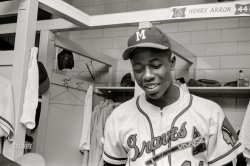
- Snow Job: 1923
- February 2, 1923. "District of Columbia, City Refuse Division." National Photo Company Collection glass negative. View ... colored outfits.
Growing up in Ohio and living in Kansas City for 20 years, I can appreciate the lifestyle of Arizona. I no ... Posted by Dave - 09/13/2011 - 11:58pm -
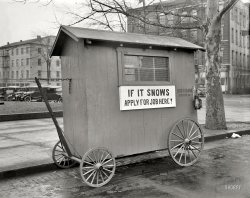
- B-29 City of Michigan: 1944
- ... WW2 B-29 bomber with flight crew taken at Walker AFF in Kansas in 1944 during training before leaving to Guam to join the 459th ... Posted by AmerHistory - 10/16/2015 - 6:23pm -
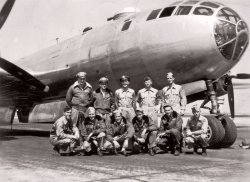
- Heart of Darkness: 1943
- March 1943. "Argentine, Kansas. Freight train about to leave the Santa Fe railyard for the West Coast." ... end of it, looking west. Argentine Yard is still there in Kansas City, KS... see Refrigerated Freight , another Delano shot on Shorpy, for ... Posted by Dave - 08/16/2014 - 12:17pm -
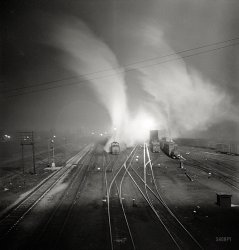
- Lush Life: 1941
- ... Johnson - but I thought Big Joe was originally based in Kansas City. Either way, great find! Him & Jimmy Rushing are my favorite shouters ... Posted by Dave - 02/29/2020 - 8:30pm -
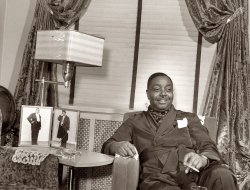
- Carrier at New Orleans: 1910
- ... rise to a number of these subsidiary companies. Love the Kansas City, Mexico & Orient boxcar!
Transfered by the Kingfish. The ... Posted by Dave - 10/24/2012 - 1:40pm -

- Aerial Omaha: 1938
- ... advertised together.
What Depression? For a small city during the worst of the later Depression years, this photo portrays an ... Fort Wayne, Omaha, St. Louis and the Gateway Arch, Kansas City, Pittsburgh) and one whole state (Oklahoma, although particularly ... Posted by Dave - 09/14/2017 - 9:05pm -
![Aerial Omaha: 1938 UPDATE: Our vantage point for this view north along 14th Street is the Woodmen of the World tower at 1323 Farnam.
November 1938. "Omaha, Nebraska." Gateway to the West. Medium format negative by John Vachon for the Farm Security Administration. View full size.
FansAnyone aware of what the contraption is on top of the building on the left. I see fan units. Was this an air conditioning system? If so it is very narrow.
Three Corner TavernsInteresting to note the small corner taverns in the Omaha photographs: in the “Omaha Suds” image, in the Theodore's Place image, and the Oaks Tavern in this image. Three corner taverns, each about the same size and height, although some more decorated than the other. I wonder how many others existed?
Across the street is the Paris Bar and Billiards. Oaks and Paris advertised together.
What Depression?For a small city during the worst of the later Depression years, this photo portrays an impressive proportion of late model vehicles. As opposed to the trucks, the great majority of the cars seen here are within 3 or 4 years of age if not newer -- a mix probably not excelled in most U.S. localities today.
Brand new Ford TudorThe car almost directly in front of the "Nebraska" is a new 1938 Standard Ford V8. I've had one of these since the late 1970's. Once considered the ugly duckling of the 30's by almost everyone is now kinda good looking. Kinda.
Scorch marksSo what was the commercial establishment that burned at the corner of 14th and Capitol? Whatever it might have been, the fire appears to have thoroughly gutted the place.
Pay no attentionI'm assuming that this picture was taken from an airplane, so it's interesting that none of the many people on the street are looking up at the photographer. It seems like an airplane flying low over the downtown area would attract a lot of attention!
[The photo was taken from the Woodmen of the World building at 1323 Farnam Street. - Dave]
Gateway to the WestJust a minute, that nickname belongs to my native city, Winnipeg, Manitoba. But wait, Wikipedia points out that it also refers to no fewer than 6 cities in the US (Fargo, Fort Wayne, Omaha, St. Louis and the Gateway Arch, Kansas City, Pittsburgh) and one whole state (Oklahoma, although particularly Tulsa).
Location, Location, Location?I believe this photo was taken from a building on the southeast corner of 14th and Farnam. In an aerial photo from the early 1950s I can see a tall building located at that corner.
Furthermore, in that aerial photo I can clearly see the Hotel Fontenelle a few blocks to the west at 1806 Douglas and I can positively identify the fronts of the buildings in the 1300 block of Douglas where Palace Billiards and the Oaks Bar were.
[You are correct about the location (my first guess, the Hotel Fontenelle, is on the wrong block). Which means our vantage point is the 19-story Woodmen of the World headquarters, at the time of its completion in 1912 the tallest building between Chicago and the West Coast. - Dave]
No Apartments AvailableThe three story brick building being demolished was an apartment building offered for sale in January 1937. Directly across the street from it was the “Hummel Auto Shed” and the Omaha World Herald delivery truck garage and parking lot and the vacant space diagonally across the street was the site of the Jefferson Hotel, demolished in 1935.
Win some, lose someBetween the Oaks Bar and the Nebraska theater is a campaign office with banners for 19938 candidacies of (James T.) English for (Douglas) County Attorney, and (Frank) McGrath for (Douglas County) Clerk of Court. English won, and later became a state-court judge. McGrath, an incumbent mired in scandals, lost.
(The Gallery, John Vachon, Omaha, Railroads)](https://www.shorpy.com/files/images/SHORPY-8b14207a.thumbnail.jpg)
- Pampa Depot: 1943
- ... this picture reminds me so much of life in a small town in Kansas. The first thing you might notice is the smell of the hot creosote from ... tall tales. I would surely rather live there than in a big city.
Sky tone Jack Delano's work continues to amaze. In this one he ... Posted by Dave - 07/22/2013 - 8:09pm -
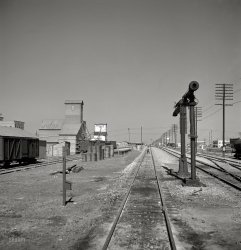
- Hawkeye Troop: 1956
- ... Troop 433 is now located in Olney which is west of the city.
http://www.troop433.org/
Jungle Greens For some reason the ... probably about 2 years older than me. I was a Cub Scout in Kansas from 1956 to 59, and a Boy Scout from 1959 to 1964. We all wore the ... Posted by Dave - 09/08/2012 - 6:29pm -
![Hawkeye Troop: 1956 "Boy Scouts 1956." Our young friend Kermy is holding the flag on the right in this Kodachrome slide found on eBay. View full size.
Balmer BoysOverlea is part of Greater Baltimore. Today's Maryland Troop 433 is now located in Olney which is west of the city.
http://www.troop433.org/
Jungle GreensFor some reason the poses in this shot, particularly of the lads squatting at the front, remind me of photos of young soldiers in Vietnam or Korea.
I guess a few years into the future from here, these lads may well have been those soldiers.
Uniformed and proud.A time when the BS wore full uniforms and looked the part. I remember having to wear the official shorts, socks, shirts, berets etc. We were proud to do that as well and were always dong some volunteer task the town asked us for. We had a huge Scout troop in my hometown 40-60 at one time. I recently went back for the 4th of July parade in the hometown and was dismayed at the look the local Scouts took on. 7-10 members now shuffling down the street: shirts un-tucked, baggy cargo shorts, flip flops; barely any trace they were indeed BS. Total slobs. Oh well.
Kermy's from Maryland!I would have guessed Iowa, glad to hear it.
Mounting evidenceSomething tells me the evidence will start building sufficiently from these photos to track down Kermy and his sister.
I wore that uniformMinus the convenient folding brimless hat, whatever you call it. I know the hat is military in origin, but I also associate it with fast food clerks. When we wore hats at all, they were ball caps.
I was one of the last Scouts to wear this style uniform. The new uniforms, with the lighter-color shirts and epaulets, were introduced about 1981. I wanted to be up to date, but my parents had just bought my uniform and were determined to wait until I outgrew it, which I did soon enough.
The Scout troops that beat everybody else in the knot-tying competitions must have worn their uniforms all the time. That wasn't us. It was only much later that I understood that they were busy perfecting these skills, while we were backpacking 100 miles, and climbing Mount Whitney. I think we had more fun.
1950 censusI wish we had access to the 1950 census, so we could look for a family in Overlea, Maryland, with a little boy named Kermit (at least I can't think of any other name that Kermy would be short for).
azhdragon is right. These kids would have been in the age group of most who served in Vietnam. Its a very sobering thought.
Scout seniorityWhen I was in Boy Scouts in the early 80s, we had the recently-introduced khaki shirt with dark OD green trousers and a mesh back baseball cap [OD green with the BSA emblem in center]. However, some of the older Scouts and a few of the adult leaders still had the old style, all-OD green uniform as shown in this photo. Sort of an indication that they were "old-timers" and still wore the older uniform to prove it. It definitely looked a lot sharper than the ones we had and was also more comfortable.
This could have beena picture of my troop in the early 60's. The garrison cap worn by these Scouts was still the official "topper" for scouts of my era.
Not that Troop 433Troop 433 of the Balto. Council still meets at a Methodist church in Perryville.
I've been trying to identify the campsite but it's not obviously either of the two local boy scout camps (Broad Creek or Hawk Mountain) or in Patapsco Park on the other side of the city.
The poseI noticed their poses as well. I think they were very consciously (without realizing it, if that makes any sense) mimicking the poses they saw their fathers taking in the unit pics from WW II.
I was a Cub Scout in 56, but graduated to the green uniforms in 1958. That hat style was what we called a garrison cap in the Marine Corps, but it had a slightly ruder common name, the p*ss cutter.
BSAMost of these kids are probably about 2 years older than me. I was a Cub Scout in Kansas from 1956 to 59, and a Boy Scout from 1959 to 1964. We all wore the long-sleeved shirt, which for reasons I never understood required you to fold the collar inside the shirt before putting on the neckerchief. When I was 14 I went on an expedition to Philmont Scout Ranch in New Mexico. The troop I went with all wore the short-sleeved shirt (which had no collar), short pants, and a campaign hat (which was an optional item.) After that, I never went back to the long-sleeved shirt, even in winter.
(Boy Scouts, Kermy Kodachromes)](https://www.shorpy.com/files/images/SHORPY_Scan-120821-0003.thumbnail.jpg)
- Florida Football: 1955
- ... and "Women"!
Jim Crow I was born and raised in Kansas and had very little exposure to Jim Crow laws until about 1954. We had ... had two side-by-side cafeterias. The public schools in my city were integrated by then but I'm quite sure that the cafeterias were built ... Posted by Dave - 09/25/2017 - 11:56am -
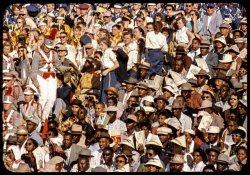
- Pilot Project: 1938
- ... flight was on a Frontier Airlines DC3 from Lincoln, NE to Kansas City, in about 1960. Before takeoff, the stewerdess handed out sticks of ... Posted by Dave - 12/15/2013 - 11:14pm -
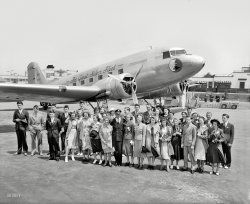
- Catskill Route: 1902
- ... in the movie "Oklahoma" when Gene Nelson comes back from Kansas City right down to the twins, however, in this case, triplets.
Huckleberry ... Posted by Dave - 10/19/2012 - 10:45am -
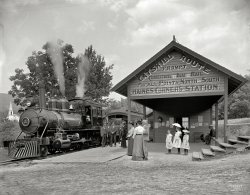
- The Stalker: 1940
- ...
Only a few days ago, it was "Everything's up to date in Kansas City."
A few days from now, it might be "This was a real nice clambake."
... Posted by Dave - 06/16/2017 - 11:34pm -
